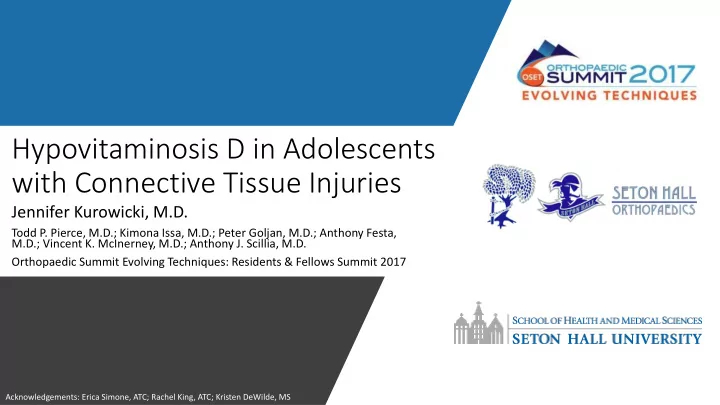

Hypovitaminosis D in Adolescents with Connective Tissue Injuries Jennifer Kurowicki, M.D. Todd P. Pierce, M.D.; Kimona Issa, M.D.; Peter Goljan, M.D.; Anthony Festa, M.D.; Vincent K. McInerney, M.D.; Anthony J. Scillia, M.D. Orthopaedic Summit Evolving Techniques: Residents & Fellows Summit 2017 Acknowledgements: Erica Simone, ATC; Rachel King, ATC; Kristen DeWilde, MS
Background • Insufficient serum vitamin D levels has been linked to poorer functional outcomes, patient reported outcomes, periprosthetic joint infection, and increased risk of severe fracture • 2012 CDC National Health and Nutrition Examination Survey • 9% of children have a serum hydroxy-vitamin D [25(OH)D] <15ng/mL • 61% of children between 15- 29ng/mL • The purpose of this study was to assess vitamin D levels of adolescent athletes with cartilaginous, tendon or ligamentous injury
• Retrospective and prospective review of a single institution’s medical records • Serum 25 hydroxy-vitamin D [25(OH)D] • Inclusion: • Age <23 years • Ligament, tendon, or cartilaginous injury • If surgery necessary, lab result must be obtained Methods prior to surgery • Exclusion: • Age >23 • History of chronic illness • History of immune modulation medication or immune deficiency disease • History of kidney or liver disease
Endocr crine S Society C Clinical Guidelines 1 2 3 Vitamin D Vitamin D Vitamin D deficiency: insufficiency: sufficiency: serum 25(OH)D of serum 25(OH)D of serum 25(OH)D of <20ng/mL 21 to 29ng/mL 30 to 100ng/mL
Res esult lts • 73 patients • 37 males and 36 females • Mean age of 17 years (SD 2; range, 11.4 to 23.5 years) • The mean 25(OH)D for the entire cohort was 27.9 ng/mL (SD 11; range, 5.7 to 83.1 ng/mL) • Males having a mean 25(OH)D of 29.2 ng/mL (SD 13; range, 9.4 to 83.1 ng/mL) • Females was 26.5 ng/mL (SD 8; range, 5.7 to 45.5 ng/mL; p=0.2956) • Forty-seven (64.4%) patients had 25(OH)D levels below the minimum recommendation of 30 ng/mL • Fif teen (31.9%) were considered vitamin D deficient at <20 ng/mL • Seasonality did not influence 25(OH)D levels amongst this cohort • mean 25.5 ng/mL in fall/winter (n=34) vs. mean 30ng/mL in spring/summer (n=39); p=0.0773)
Res esults: s: Me Mean 25 25-Hydrox oxy Vita tamin D D [25( 5(OH)D] L ] Lev evels by by Injur ury T Type
• Majority of adolescents with tendon, ligamentous or cartilaginous injuries, regardless of gender or season, have serum 25-hydroxy- vitamin D levels below the minimum Conclusions recommendation • Further investigation into the role of vitamin D in the bone-connective tissue interface is warranted.
Thank you! Questions?
Recommend
More recommend